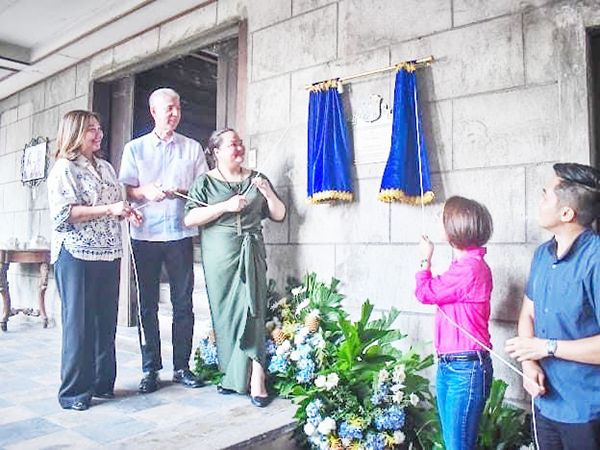7 Negros Occidental landmarks in UNESCO world heritage site tentative list
BACOLOD CITY – Seven landmarks in Negros Occidental, which are part of the Sugar Cultural Landscape of Negros, have been tentatively listed as a world heritage site of the United Nations Educational, Scientific, and Cultural Organization.

CECILIA Tirol (second from right), director for Visayas Museums of the National Museum of the Philippines (NMP), the Yulo family, represented by Ynes Reyes Ganuelas (third from left), and local government officials headed by Negros Occidental Gov. Eugenio Jose Lacson (second from left) and Bacolod Councilor Em Ang (left), unveil the national historical marker at Yulo’s Park in Barangay 14, Bacolod City on Thursday, August 22. (Photo courtesy of Bacolod PIO)
They are the Victorias Milling Co. in Victorias City, Hacienda Rosalia in Manapla town, Historic Center of Silay City, the Hawaiian-Philippine Company sugar mill in Silay City, Balay ni Tana Dicang and the Aniceto Lacson Ancestral House in Talisay City, and the Yulo’s Park here.
Gov. Eugenio Jose Lacson, during the world heritage bid for the sugar cultural landscape of Negros and Panay Islands at Negros Residences here last week, said that the sugar industry has been a corner stone in the history of Negros and Panay, thriving economic progress, and cultural development.
“The story of Negros Occidental is intricately link to sugar, as one cannot be thought of without the other,” he added.
Lacson said that vast sugarcane fields, grand ancestral homes, and heritage sites, and even the laidback lifestyle, all tell the stories of how the communities have been shaped by this industry, creating a lasting influence that spans generations.
“As we pursue this world heritage recognition, we are not only commemorating our heritage or gain acknowledgment in the work, but also reaffirming our dedication to safeguarding our history for present and future generations,” he added.
The Balay ni Tan Juan in Bago City and the Negros Occidental Capitol here are also being considered on the the list.
The National Museum of the Philippines unveiled a national historical marker at Yulo’s Park in Barangay 14 here on August 22.
The 105-year-old park, now considered as an Important Cultural Property of Bacolod, was built by the late Don Mariano Yulo, former Negros Occidental governor and senator during the Commonwealth period, whose son, Alfredo Yulo, also played a significant role in the city’s history, having served as the mayor of Bacolod from May 27, 1940, to May 29, 1942.
In her message, lawyer Cecilia Tirol, director for NMP Visayas Museums, who led the unveiling of the marker, stressed the importance of preserving such landmark because losing such tangible, represented by the edifice, means losing much of a story that goes with it.
Councilor Em Ang, chairperson of the City Council Committee on History Culture and Arts, said that every year, many beautifully designed heritage public buildings like churches and schools are lost to gradual deterioration from physical elements to commercialism.
Ang stressed that historical buildings or spaces serve as visual reminders of the past and they connect people to the communities.
For aesthetic and economic reasons, preserving historical buildings or spaces can bring charm or character to a neighborhood, community, or a city, creating a synergy, and contributing to the economic livelihood of the community through tourism, the councilor said.
Ang said they are collaborating with the owners for the restoration of Yulo’s Park as they to make it a tourist destination. But she said the city will have to discuss the budget allocation for its restoration.
Lacson said that historical markers serve as tangible reminders of the times that have defined the Negrense society and stand as testament to the remarkable individuals, events, and places that deserve recognition and remembrance.
These markers, more than telling a story, commemorates the lives of great leaders and everyday heroes who have made the province what it is today, Lacson said.
“It is our task to ensure that their stories are told, retold, and never forgotten, and must resonate through the ages,” he added.
“History is more than just a narration of facts and dates, it is the story of who we are as a people, the triumphs and struggles that shaped us, and the legacies we have inherited,” he said.
Lacson said that young people must be encouraged to explore their roots to appreciate the struggles and achievements of those who came before them.
“Let us ensure that historical markers become not just static symbols, but catalyst for learning and inspiration and a road map to understanding our roots,” he added.
He thanked the City Council for passing a resolution declaring the park as an ICP. “This is a demonstration of our commitment to preserving and celebrating the rich history of our province,” he said.
Ynes Reyes Ganuelas, who represented the Yulo family, expressed her deep gratitude for the support, and is hoping to restore the park to its former glory, revive history, and share it with generations to come.